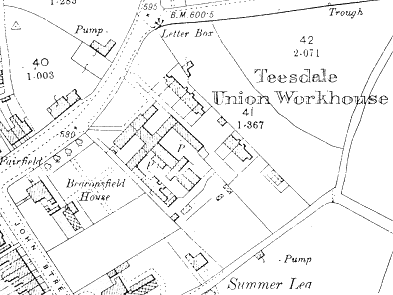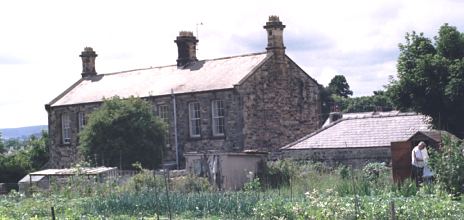Teesdale, Durham
Up to 1834
A parliamentary report of 1777 recorded local workhouses in operation at Barnard Castle (for up to 50 inmates), Bowes (20), Egleston (12), Gainford (20), Middleton (12), and Newbiggin (12). In 1827, Barnard Castle's workhouse was recorded as being located on "De Mains". In the same year, a workhouse existed at Staindrop.
After 1834
Teesdale Poor Law Union formally came into existence on 18th February 1837. Its operation was overseen by an elected Board of Guardians, 52 in number, representing its 44 constituent parishes as listed below (figures in brackets indicate numbers of Guardians if more than one):
County of Durham:
Barnard Castle (5), Cleatlam, Cockfield, Eggleston, Forest and Frith, Gainford, Headlam, Hilton, Ingleton, Langleydale and Shotton, Langton, Marwood, Middleton (3), Morton Tinmouth, Newbiggin, Raby with Keverstone, Staindrop (2), Streatlam and Stainton, Wackerfield, Westwick, Whorlton, Winston, Woodland.
North Riding of Yorkshire:
Barforth, Barningham, Boldron, Bowes, Brignall, Cotherstone, Egglestone Abbey, Gilmonby, Holwick, Hope, Hunderthwaite, Hutton Magna, Lartington, Lunedale, Mickleton, Ovington, Rokeby, Romandkirk, Scargill,
Startforth, Wycliffe with Thorpe.
The population falling within the Union at the 1831 census had been 19,839 with parishes ranging in size from Morton Tinmouth (population 19) to Barnard Castle (4,430). The average annual poor-rate expenditure for the period 1834-36 had been £7,730 or 7s.10d. per head of the population.
The Teesdale Union workhouse was erected at Barnard Castle in 1838. The architect was John Green whose design was clearly based on the Poor Law Commissioners "200-pauper" model workhouse plan published in 1836. Later additions included a separate infirmary and infectious ward. The workhouse location and layout are shown on the 1892 OS map.

Teesdale Union workhouse site, 1892.

Teesdale infirmary block from the west, 2001.
© Peter Higginbotham.

Teesdale block from the north, 2001.
© Peter Higginbotham.
The workhouse buildings are largely demolished but the infirmary and another block, possibly the infectious ward, still survive as office accommodation.
Staff
Inmates
Records
Note: many repositories impose a closure period of up to 100 years for records identifying individuals. Before travelling a long distance, always check that the records you want to consult will be available.
- Durham County Record Office, County Hall, Durham DH1 5UL. Almost no local records survive.
Bibliography
- Higginbotham, Peter The Workhouse Encyclopedia (2014, The History Press)
Links
- None.
Unless otherwise indicated, this page () is copyright Peter Higginbotham. Contents may not be reproduced without permission.


